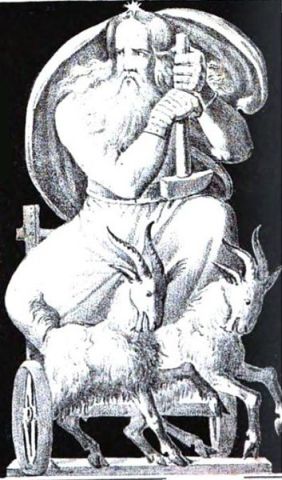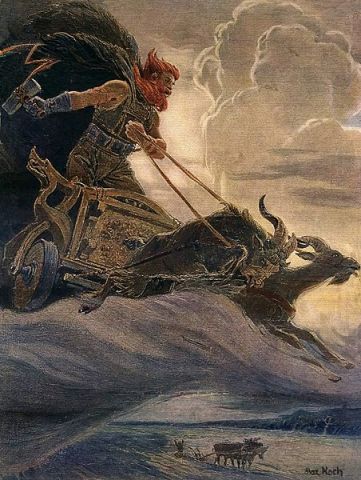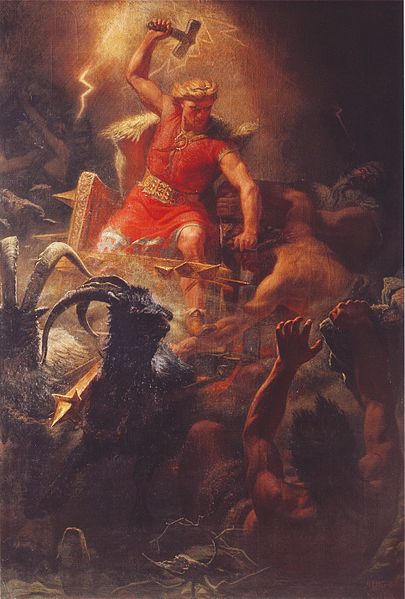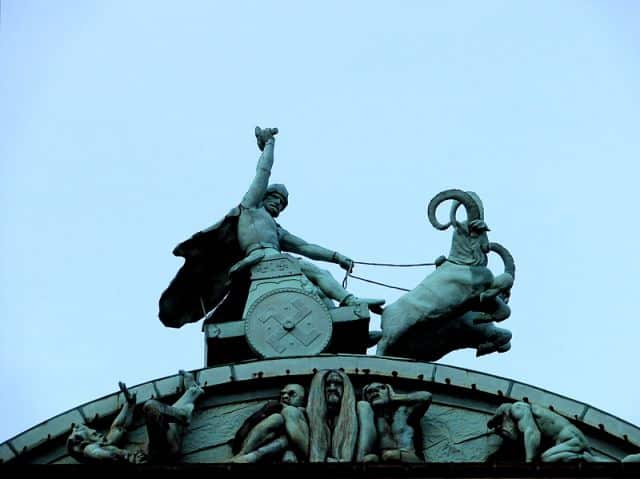Just like Thor wouldn’t be himself without his hammer Mjolnir, his two goats Tanngrisnir and Tanngnjóstr are also important to him. Pulling Thor’s chariot across the sky, land or water, they seem to be no less remarkable than Odin’s eight-legged horse Sleipnir.
The Origins of Tanngrisnir and Tanngnjóstr

Not much, or anything at all really, is known about where Thor got his goats. They seem to have been with him for as long back as we know.
Etymology and meaning of the names Tanngrisnir and Tanngnjóstr
The names of Thor’s two goats, Tanngrisnir and Tanngnjóstr, carry significant meaning. This is providing further insights into their roles and attributes within Norse mythology.
Tanngrisnir, the first of the two goats, derives its name from Old Norse words “tönn,” meaning “tooth,” and “grisnir,” which can be translated as “snarler” or “barer.” The name Tanngrisnir, therefore, can be understood to mean “teeth-barer” or “teeth-snarler.” This name is quite indicative of the goat’s ferocious nature and alludes to its aggressive disposition, much like the god it serves. The fierce imagery evoked by this name reflects the importance of strength and might in Norse culture, particularly when associated with the god of thunder.
The second goat, Tanngnjóstr, has a similarly intriguing etymology. Its name is a compound of the Old Norse words “tönn,” again meaning “tooth,” and “gnjóstr,” which translates to “grinder.” Thus, Tanngnjóstr means “teeth-grinder.” This name, like Tanngrisnir, conjures up a fierce and intimidating image, highlighting the goat’s aggressive nature. The emphasis on grinding teeth in this name suggests a relentless and unyielding spirit, traits that would be highly valued by the ancient Norse people, who often faced harsh conditions and adversity.
Symbolic significance of goats in Norse mythology
Goats in Norse mythology symbolize strength and resilience, making them perfect companions for Thor, the god of thunder and strength. As such, Tanngrisnir and Tanngnjóstr are more than mere animals; they embody the very essence of power and might. In this way, the goats serve as an extension of Thor’s own divine attributes, further solidifying their importance in these ancient myths.
Thor’s goats play a significant role in his travels, as they pull his chariot across the sky. This image of a powerful god being drawn by mighty goats emphasizes the close relationship between Thor and his trusty steeds. Moreover, the goats’ presence adds a layer of symbolism to Thor’s character, connecting him to the earth and its creatures, and underlining his role as a protector.
Stories and References Involving Thor’s Goats
Thor’s goats pop up in several stories in both the Prose- and Poetic Edda. Some are quite straightforward, while other mentions provide information you have to infer from the text.
Prose Edda – Gylfaginning

The Prose Edda, written by Snorri Sturluson, is one of the most famous accounts involving Thor’s goats. In this work, the goats are described as the powerful creatures pulling Thor’s chariot. Moreover, they are also said to be responsible for the sound of thunder as they gallop through the sky. This description emphasizes the goats’ strength and their connection to Thor.
In the Gylfaginning section, chapter 14, we find the story that describes Thor’s ability to resurrect his goats. We also learn what happened to the boy who broke one of the bones and his innocent sister.
Gylfaginning Chapter 14
“The beginning of this adventure is that Thor went on a journey with his goats and chariot, and with him went the Aesir who is called Loke. In the evening they came to a farmer and got there lodgings for the night. In the evening Thor took his goats and killed them both, whereupon he had them flayed and borne into a kettle. When the flesh was boiled, Thor and his companion sat down to supper.
Thor invited the bonde (farmer), his wife and their children, a son by name Thjalfe, and a daughter by name Roskva, to eat with them. Then Thor laid the goat-skins away from the fire-place, and requested the farmer and his household to cast the bones onto the skins.
Thjalfe, the bonde’s son, had the thigh of one of the goats, which he broke asunder with his knife, in order to get at the marrow, Thor remained there overnight. In the morning, just before daybreak, he arose, dressed himself, took the hammer Mjolner, lifted it and hallowed the goat-skins.
Then the goats arose, but one of them limped on one of its hind legs. When Thor saw this he said that either the bonde or one of his folk had not dealt skillfully with the goat’s bones, for he noticed that the thigh was broken. It is not necessary to dwell on this part of the story.”
Prose Edda – Skáldskaparmál
In the Skáldskaparmál, we find more references to Thor’s goats. Kennings, a figurative phrase used in Old Norse poetry, often alludes to Tanngrisnir and Tanngnjóstr as symbols of Thor’s power. This literary device further emphasizes the connection between the goats and thunderstorms or bad weather, solidifying their association with the god of thunder.
Poetic Edda – Hymiskvida
The Poetic Edda offers many tales of Thor and his goats pop up in a couple of them. In the Hymiskviða, Thor embarks on a journey to the giant Hymir’s hall to acquire a massive cauldron. In this old poem, likely one of Snorri’s sources when writing the Prose Edda, the broken leg is also mentioned.
However, while the story is about Thor and Tyr, when the goat’s broken leg is mentioned, Loki is blamed. This inconsistency might be on the narrator’s part, or be two stories flowing into each other.
Poetic Edda – Thrymskvida
In the Thrymskvida, where the giant Thrym steals Thor’s hammer, the goats are also mentioned. The mention also touches on how they leave a wake of fires behind the chariot as they travel to Jotunheim.
Stanza 21.
“Then the goats were driven home to the hall,
They pulled at their halters, they ran swiftly;
The mountains burst and the earth burned with fire,
And Thor, Othin’s son, sought Jotunheim.”
Poetic Edda – Grimnismál
In the Grimnismál poem from the Poetic Edda, you can infer some things about Thor’s goats and chariot. While it’s not stated directly, his chariot and the goats create thunder and lightning when they travel. Typically for the Old Norse poems however, this is not always the case as it doesn’t seem to be a problem in other stories.
In stanza 29 and 30, Odin in the guise of Grimnir, tells how the gods meet by the Yggdrasil every day to discuss important matters. While all the other gods ride there across the Bifrost bridge, Thor is forced to wade across two rivers and two hot springs. Otherwise, meaning if he were to drive his chariot across the Bifrost bridge, it would be all in flames. Simply wading the rivers, understood as doing it in the goat driven chariot, makes the water boil.
“29. Kormt and Ormt, | and two hot springs,
Thor wades through,
each day,
As he judges fairly,
By the ash Yggdrasil,
Or else the gods bridge
Burns in flames,
And the flowing water boils
30. Glad and Gyllir, | Glær and Skeidbrimir,
Silfrintop and Sinir,
Gisl and Falhofnir, | Gulltop and Lettfeti,
On these horses the the Aesir ride
every day, | when they go to judge
By the ash Yggdrasil.”
Play Fun Norse Quiz
Is this article making you even more curious about Norse gods and goddesses? You can satisfy your curiosity by playing a fun Norse mythology quiz. This way, you can test your knowledge about Norse gods and goddesses, as well as fill in some gaps. Good luck and have fun playing!
Don’t forget to try our other games as well!
The Magical Abilities of Tanngrisnir and Tanngnjóstr

Tanngrisnir and Tanngnjóstr possess unique resurrection powers, closely tied to Thor’s legendary hammer, Mjölnir. When slain and cooked as a meal, they can be brought back to life the next day. However, as we learned already the bones need to be intact, otherwise the goats are harmed. The story never really states if the goat’s bone will heal or not, but let’s hope so.
This cycle of slaughter, being eaten and then resurrected is not unique to Tanngrisnir and Tanngnjóstr however. In stanza 18 of Grimnismál we learn how all the Einherjar living in Valhalla are fed each evening.
“18. In Eldhrimnir | Andhrimner cooks
Sæhrimnir’s sizzling flesh,
The best of food, | but few men will know
What the Einherjar feasts on.”
So the cook Andhrimner cooks the boar Sæhrimnir each night, yet the next morning the boar is resurrected. We don’t know how the boar is brought back to life, but Thor has to use Mjolnir to perform this for the goats.
Thor’s goats are actually not the only magical goat in Norse mythology. Also told in the Grimnismál, stanza 25, we hear about the goat Heidrun, that provides an unending flow of mead.
“25. The goat Heidrun | stands by Odin’s hall,
Feeding on the branches of Læradr;
Filling large pitchers | with the best mead,
A never ending flow.”
The symbolism of renewal and regeneration in Norse mythology
The goats’ (and the hapless boar’s) resurrection ability might also symbolize renewal and regeneration, essential themes in Norse mythology. By linking these concepts to the goats, the myths underscore the cyclical nature of life and death, reflecting the Norse belief system. In their mind, death was only a part of the journey on to an afterlife.
Thor’s Goats in Modern Pop Culture
Moreover, being a fun break from all the horses others travel on, Thor’s goats have been portrayed in literature, comic books, movies, and video games. These contemporary adaptations seem to keep the legacy of Tanngrisnir and Tanngnjóstr alive and relevant even today.
Depictions in Neil Gaiman’s Norse Mythology
If you haven’t listened to the audiobook of Neil Gaiman’s “Norse Mythology” I recommend it wholeheartedly. Gaiman reads it himself and his fascination and expert storytelling comes to life in the reading.
His “Norse Mythology” offers a modern retelling of the ancient tales, also featuring Thor and his goats. Moreover, by adapting these stories for contemporary audiences, Gaiman ensures that the legacy of the Old Norse endures.
Portrayals in the Marvel Cinematic Universe
Thor’s goats also appear in comic books and movies, particularly in the Marvel Cinematic Universe. These adaptations have introduced a whole new generation to the tales of Thor and his goats, further solidifying their importance in modern pop culture.
The 2022 MCU movie Thor: Love and Thunder makes extensive use of the goats and there are a couple of hilarious instances where they really come into their own. If you have been thinking that Thor’s goats must be something different than your normal goat, you are right!
FAQs
Thor’s goats are named Tanngrisnir, meaning “teeth-barer” or “teeth-snarler,” and Tanngnjóstr, meaning “teeth-grinder.” Both names emphasize their ferocious nature and loyalty to Thor.
The goats have unique resurrection powers. When killed and eaten, they can be brought back to life the next day by Thor using his hammer, Mjölnir, as long as their bones remain unbroken.
As the goats pull Thor’s chariot through the sky, their hooves create the thunderous sounds associated with the god of thunder, connecting the goats to the natural phenomenon.
Thor’s goats appear several times in both the Prose Edda and the Poetic Edda. Gylfaginning and the Skáldskaparmál from the Prose Edda and Grimnismál, Thrymskvida and Hymirskvida from the Poetic Edda.
When a bone is broken, as in the case of the farmer’s son Þjálfi, the resurrected goat will have a lame leg. The person responsible must make amends, like Þjálfi, who was required to serve as Thor’s servant.
Tanngrisnir and Tanngnjóstr appear in contemporary literature, comic books, movies, and video games, such as Neil Gaiman’s Norse Mythology, the Marvel Cinematic Universe, and the God of War series.
Featured Image Credit: Lorenz Frølich, Public domain, via Wikimedia Commons

